Tag archives: particle accelerator
Space-station toilet tour, the Louvre’s particle accelerator and more
By Tushna Commissariat
I’m sure that many of us, while watching videos of astronauts on board the International Space Station (ISS), floating around with their halo-like hair, have given much thought to how they shower, wash their hair, brush their teeth and, indeed, poop and pee! Well, you can stop stretching your imagination and take a look for yourself – we spotted this story on the Slate website, where you can see the latest videos from the European Space agency, where Italian astronaut Samantha Cristoforetti, who is currently on the ISS, gives us a tour of both the toilet (above) and the “shower” area (below). She even demonstrates exactly how to wash your hair in space – it looks rather fuss-free if you ask me!
Isaac Newton’s Good Friday, art meets physics and our favourite April Fool gags
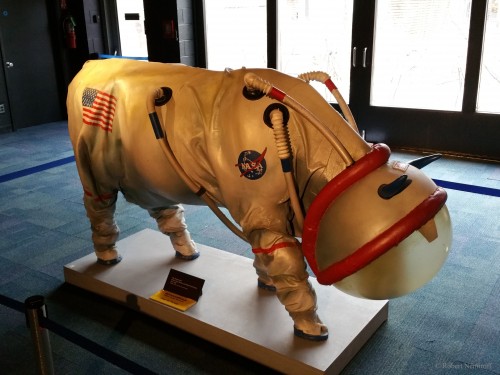
Suiting up for the Moon – an artwork aptly titled “Mooooonwalk”. (Courtesy: APOD/ Robert Nemiroff/Michigan Technological University)
By Hamish Johnston and Tushna Commissariat
As it’s Good Friday today, it can only mean that this week’s Red Folder will include a selection of the best physics-related April Fool jokes from earlier this week. Fermilab’s daily e-bulletin Fermilab Today had an entire joke edition up in the morning – their lead story was probably our favourite as the lab announced its new breakfast cereal dubbed “Neutrin-Os”, but their new day spa sounds pretty good too. CERN went for the funny if slightly obvious Star Wars joke, confirming the existence of the Force, but a slightly more subtle joke came earlier in the week from CERN Bulletin, which ran a story about CERN’s computer-security department handing out prizes for best password – we are still not quite sure if they were joking or not! Astronomy Picture of the Day had a truly fantastic image (see above) of a Lunar Grazing Module described as a “multipurpose celestial bovine containment system”.
Last views of a huge particle detector before the Large Hadron Collider comes to life
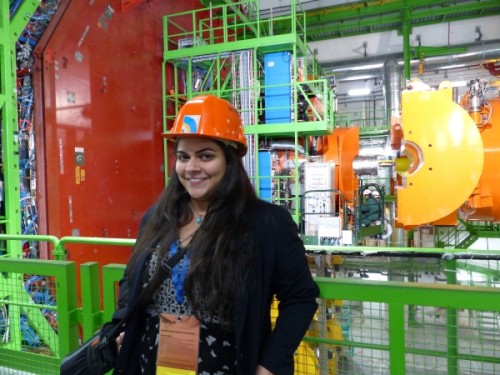
My photo opportunity: this could be the last we will see of the CMS for three years.
By Tushna Commissariat at CERN
Regular readers of Physics World will know that I am currently visiting the CERN particle physics lab in Geneva, ahead of the restart of the Large Hadron Collider (LHC) in the coming weeks. My first stop yesterday afternoon was a press conference in which CERN’s director-general Rolf Heuer and other leading physicists briefed us about “Run 2” and what researchers are hoping to discover. You can read about what they had to say here: “Large Hadron Collider fires up in a bid to overturn the Standard Model“.
I managed to squeeze in a quick last-minute visit to the Compact Muon Solenoid (CMS) detector before it is sealed up tight for the next three years. My host was CMS communications officer Achintya Rao, who took me and a few others deep underground into the bowels of the CMS – and what a sight it was!
View all posts by this author | View this author's profile
Extra dimensions, other-worldly football, the ISS at night and more
By Tushna Commissariat
This week, we came across the above video on “extra dimensions”, in which physicist Don Lincoln talks about the possible physical reality of such dimensions and why we need them. The video begins with Lincoln pointing out just how weak a force gravity is, especially when compared with, say, magnetism. He then goes on to talk about how gravity may exist in more than the three dimensions we experience, making sure to point out that these “extra dimensions” are not of the Hollywood variety in which a different reality may exist. This video is part of Fermilab’s “Big Mysteries” video series – be sure to take a look at the rest.
Proton therapy is for the masses
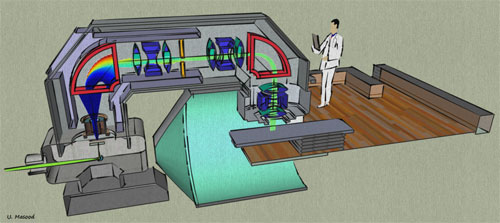
Drawing of the proposed proton-therapy facility. (Courtesy: Umar Masood)
By Hamish Johnston
In the 25th anniversary issue of Physics World, I made the bold assertion that laser acceleration will bring particle therapy to the masses by removing the need for treatment centres to have large and expensive accelerators. Instead, therapeutic beams of protons and other charged particles will be made using compact and relatively inexpensive lasers.
Now, medical physicist Umar Masood and colleagues at the Helmholtz-Zentrum Dresden-Rossendorf (HZDR) and the University of Dresden have published plans for a laser-driven proton-therapy facility.
Rebirth of the SSC?

Physicists entering the derelict site of the Superconducting Super Collider in 2011.
By Michael Banks
Following the closure of Fermilab’s 1 TeV Tevatron particle collider near Chicago in 2011 – and with no similar facility being planned to replace it in the US – many physicists in the country felt not surprisingly concerned that America was losing its place at the “energy frontier”. That baton had already passed to the CERN particle-physics lab near Geneva when its Large Hadron Collider (LHC) fired up in 2008, and with collisions set to restart there next year at 13 TeV, the US’s day looked certain to have passed.
View all posts by this author | View this author's profile
CERN creates new office for medical research
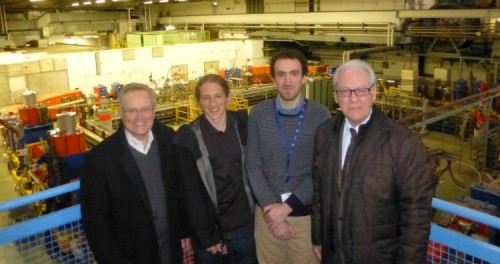
Steve Myers (far left) and colleagues at the LEIR facility.
By Hamish Johnston
Earlier this month my colleague Tami Freeman was at CERN where she had a tour of what will soon be the Geneva-based lab’s first major facility for biomedical research. Called BioLEIR, the facility is now being created by modifying the existing Low Energy Ion Ring (LEIR).
View all posts by this author | View this author's profile
Colliding exhibits, influential researchers, edible particle-detectors and more
By Matin Durrani and Tushna Commissariat
If you’re in the tiny minority of people whose job title says “particle physicist”, chances are you’ll have been to CERN at least once in your career to help build a detector, analyse some collision data or muse in the cafeteria over supersymmetry (or the apparent lack of it so far). But for the rest of the world, going to the Geneva lab is simply not on the agenda, which is one reason why the Science Museum in London has this week unveiled a big new exhibition devoted to CERN’s Large Hadron Collider. Entitled simply Collider, the exhibition “blends theatre, video and sound art with real artefacts from CERN” that will, say organizers, “recreate a visit to the famous particle-physics laboratory”.
View all posts by this author | View this author's profile
Four quarks for Muster Mark?

Family of four? (Courtesy: Shutterstock/paul_june)
By Tushna Commissariat
In June we reported that physicists working on the BESIII experiment in Beijing and the Belle experiment in Tsukuba, Japan found evidence for a new “charged charmonium” called Zc(3900). A “charged charmonium” is a particle that is made of four quarks – something that had never been seen before. Since that discovery, the BESIII collaboration says it has made “a rapid string of related discoveries” of four-quark particles. “While quarks have long been known to bind together in groups of twos or threes, these new results seem to be quickly opening the door to a previously elusive type of four-quark matter,” says Frederick Harris, spokesman for the BESIII experiment. “The unique data sample collected by the BESIII collaboration has continued to yield a stream of clues about the nature of multi-quark objects.”
Laser accelerator breaks the gigaelectronvolt barrier
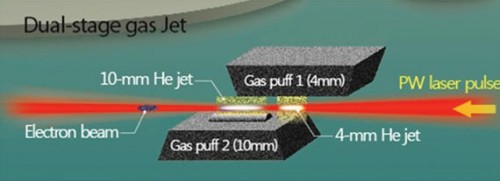
Schematic showing the laser passing through the two gas jets.
(Courtesy: Hyung Taek Kim et al. Phys. Rev. Lett. 111 165002)
By Hamish Johnston
There is an interesting paper in Physical Review Letters this week with the mouthful of a title: “Enhancement of electron energy to the multi-GeV regime by a dual-stage laser-wakefield accelerator pumped by petawatt laser pulses“. This piqued my interest because I recently wrote an article for the 25th anniversary issue of Physics World that looks at how laser acceleration of protons and other hadrons could make certain cancer therapies more accessible.
View all posts by this author | View this author's profile
